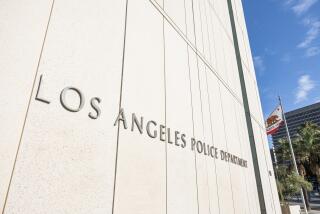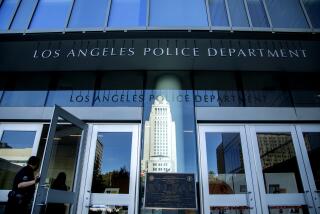Cloud Over Police Unit : Amid yet another shooting controversy, the question of whether the LAPD needs its Special Investigations Section must be squarely faced.
- Share via
Once again, the Los Angeles Police Department’s Special Investigations Section has briefly surfaced in spectacular fashion. The event: another deadly shootout in broad daylight, this time involving a gang suspected of committing at least 25 armed robberies of travel agencies. Two suspects were killed, each with single gunshots in the back.
The reaction in these situations generally follows a tight script--a call from the U.S. attorney’s office for an FBI investigation of the incident. In this case, an internal LAPD investigation is underway too. The Police Commission and its inspector general are also looking into the matter.
They need to weigh justifications for the existence of SIS. Could it be an anachronism that ought to be disbanded? Is it efficient in terms of the few arrests it makes? What standards and training should be required of the unit? Are its tactics, avoided by other police departments around the nation, appropriate here? And with crime rates falling over the past several years and 2,000 more officers on the streets, is SIS necessary at all?
It’s time to look at these questions in a hard light, with public hearings.
“The primary mission of SIS is to handle major cases in which you do not have sufficient [evidence] to file a case,” LAPD Police Chief Bernard C. Parks told The Times Thursday. “SIS is unique. No one else is trained to do this kind of work. You can’t just round people up out of squad cars and tell them to go out and conduct surveillance. You will always need SIS if you have any hope of dealing with these kinds of cases.”
SIS was formed 34 years ago in a manner that would be entirely unacceptable today. It was created with little public announcement and given broad surveillance powers throughout the city, with few standards and restrictions on how it would operate. Its assignments typically involve groups suspected of major crimes, and its tactics include surveillance and, when possible, catching criminals in the act. By the LAPD’s own accounting, SIS members have been involved in 54 shootings, resulting in 26 fatalities among suspects and many more woundings. Why?
Parks said SIS members deal with the most serious crimes and the most dangerous suspects and have much more reason to expect violence because their suspects typically have just committed a violent act.
The 20-member unit makes, on average, 46 arrests per year. It operates on an annual budget of $2 million, but related costs must be considered. Court cases brought against the unit, federal probes, U.S. attorney reviews and grand jury inquiries add to taxpayer costs.
To the credit of SIS, it has been involved in breakthrough arrests in the cases of the Alphabet Bomber, the Freeway Strangler and Mikail Markhasev, convicted of the murder of Bill Cosby’s son, Ennis. And when SIS does make arrests, it can clear cases in bunches. One example was the arrest of a group of “follow-home” robbers suspected of attacking 120 elderly victims. Between August 1998 and August 1999, SIS handled 50 robberies, 18 homicides, 30 burglaries, five kidnappings and three other crimes.
Might SIS tactics be better suited to military antiterrorism units than civilian law enforcement? To that, LAPD Cmdr. David J. Kalish says, “These [criminals] are urban terrorists.”
The city deserves to hear much more about this unit, and elected and appointed public officials should lead the way.
More to Read
Sign up for Essential California
The most important California stories and recommendations in your inbox every morning.
You may occasionally receive promotional content from the Los Angeles Times.










